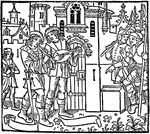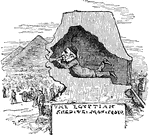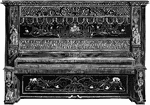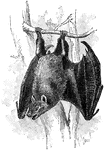
Egyptian Free-Tailed Bat
The Egyptian Free-Tailed Bat (Tadarida aegyptiaca) is a species of bat in the Molossidae family of free-tailed…

Egyptian Amphora Shape
This Egyptian amphora is a vase with a cover intended for water, oil or wine. It was found in Thebes,…

Egyptian Amphora
This Egyptian amphora is a vase with a cover intended for water, oil or wine. It was found in Thebes,…

Egyptian Urn
This Egyptian urn is shown here with two egyptians rubbing the urn. The urn was typically used in funeral…
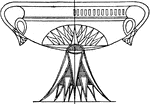
Egyptian Krater
The Egyptian Krater is an antique vase that has a lotus cup design. Typically used for mixing water…

Egyptian Krater from Thebes
This Egyptian Krater is an antique vase that was found in Thebes, Ancient Egypt during the eighteenth…
Egyptian Phiale
The Egyptian phiale with cover is a slender vessel without handles. It has an elongated body with a…
Egyptian Bucket from Thebes
This Egyptian bucket was found in Thebes, Ancient Egypt during the reign of Tutmose III. An Egyptian…

Egyptian Bronze Bucket
This Egyptian bucket is made out of bronze. An Egyptian origin it was used to draw water from the Nile.…
Egyptian Bucket
This Egyptian bucket is made out of bronze. An Egyptian origin it was used to draw water from the Nile.…

Egyptian Bucket with Handle
This Egyptian bucket is made out of bronze. An Egyptian origin it was used to draw water from the Nile.…

Egyptian Vessel
This Egyptian vessel is bucket-like without a handle. It was used to transport water from the Nile.
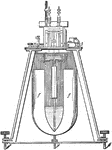
Quadrant Electrometer
An illustration of a quadrant electrometer. An electrometer is an electrical instrument for measuring…
Tuning Fork
A tuning fork is an acoustic resonator in the form of a two-pronged fork with the tines formed from…

Tuning Fork
A tuning fork is an acoustic resonator in the form of a two-pronged fork with the tines formed from…
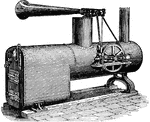
Brown's Siren Foghorn
"1. A horn used on board a vessel to sound a warning signal to other vessels in foggy weather. 2. A…

Seated Egyptian Figure with Hieroglyphics Pictured to the Right
An Egyptian figure wearing a headdress with a snake, is seated on a stool with an ornamental design…
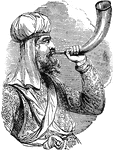
Jewish Priest Sounds Shofar
A Jewish priest sounds the shofar or ram's horn. The shofar is a ceremonial horn used in Jewish worship…
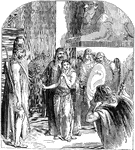
The Egyptian King Taking the Wife of Abram
"The princes also of Pharaoh saw her, and commended her before Pharaoh: and the woman was taken into…

Moses Slaying the Egyptian
"And he looked this way and that way, and when he saw that there was no man, he slew the Egyptian, and…
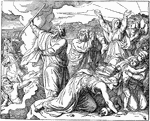
Pharaoh's Host Destroyed
"And Moses stretched out his hand over the sea; and Jehovah caused the sea to go back by a strong east…
Positioning Pen for Constructions
Illustration showing the correct and incorrect position of a right line pen against a T-square, triangle,…
Wheat
Egyptian wheat (Sorghum bicolor) has long slender stalks growing seven to ten feet. It matures late…

Three Men Playing String Instruments
An illustration of three men playing string instruments, one playing the cello and two playing the violin.

Ramesses II Returning From Syria
An illustration of an Egyptian hieroglyphic depicting Ramesses II returning in triumph from Syria.

Judgment of the Dead
An illustration of an Egyptian hieroglyphic depicting the judgment of the dead. "An ape-assessor scourages…
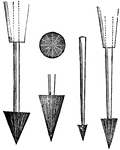
Egg Drills are Special Tools Used for Preparing and Blowing Eggs
"Figure 4 - egg-drills, different sizes. Steel implements with a sharp-pointed conical head of rasping…

Several Special Instruments Used in the Process of Egg Blowing
"Figure 5-Instruments for blowing eggs; a,b, blow-pipes, 1/2 natural size; c, wire for cleansing them;…
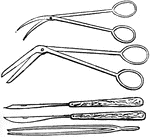
Scissors, Knives, and Forceps Used for Egg Blowing
"Fig. 6- scissors, knives, and forceps, 1/2 natural size." Elliot Coues, 1884 These items may be used…

Hooks Used in the Process of Egg Blowing for the Purpose of Extracting Embryos
"Figure 7-hooks for extracting embryos, natural size; a,b,c, plain hooks; d, bill-hook, having cutting…
Fire Irons
These fire irons are metal instruments that are used for tending a fire, particularly a fireplace.
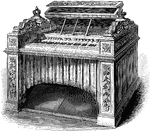
Harmonium
The harmonium is a free standing keyboard instrument, similar to a reed organ or a pipe organ.

Harmonium
The harmonium is a type of keyboard instrument similar to an organ. The sound is produced by air using…
Guitar
This guitar has a spanish style design with a floral design in the center and around the edges. It has…
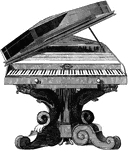
Piano
This piano is made to serve as a table when closed. It is designed with two figures of reptiles at the…

Egyptian Kitchen
"Scene in Egyptian kitchen, showing use of a large rope to support a sort of hanging shelf." -Hill,…

Egyptian Rope Making
"Reproduction of sculpture from a tomb in Thebes, showing preparation of leather cords by process similar…

Egyptian Sandal Makers
"The Ancient Sandal Maker as pictured on the wall of the ruined temples at Thebes, Egypt." -Bodmer,…

Plan of the Temple of Chons, 2134–1999 BC
This is a plan of the Temple of Chons (Khonsu) in Luxor, Egypt. Egyptian-style architecture. Scale in…

Plan of Karnak, 2134–1999 BC
This is a map of the Plan of Karnak, near Luxor, Egypt. Egyptian–style architecture. "The…









